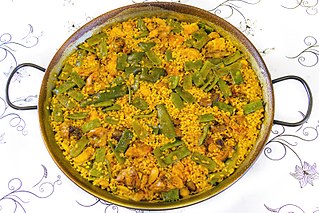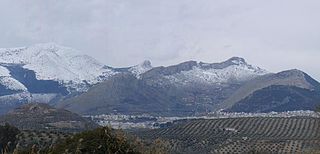Related Research Articles

Gazpacho or gaspacho, also called Andalusian gazpacho, is a cold soup and drink made of raw, blended vegetables. It originated in the southern regions of the Iberian Peninsula and spread into other areas. Gazpacho is widely eaten in Spain and Portugal, particularly during hot summers, since it is refreshing and cool.

Olive oil is a liquid fat obtained by pressing whole olives, the fruit of Olea europaea, a traditional tree crop of the Mediterranean Basin, and extracting the oil.

The olive, botanical name Olea europaea, meaning 'European olive', is a species of small tree or shrub in the family Oleaceae, found traditionally in the Mediterranean Basin, with wild subspecies found further afield in Africa and western Asia. When in shrub form, it is known as Olea europaea'Montra', dwarf olive, or little olive. The species is cultivated in all the countries of the Mediterranean, as well as in Australia, New Zealand, North and South America and South Africa. It is the type species for its genus, Olea. The tree and its fruit give their name to the Oleaceae plant family, which also includes species such as lilac, jasmine, forsythia, and the true ash tree.

Spanish cuisine consists of the traditions and practices of Spanish cooking. It features considerable regional diversity, with significant differences among the traditions of each of Spain's regional cuisines.

Tapas are appetisers or snacks in Spanish cuisine. They can be combined to make a full meal and are served cold or hot. In some bars and restaurants in Spain and across the globe, tapas have evolved into a sophisticated cuisine. In some Central American countries, such snacks are known as bocas. In parts of Mexico, similar dishes are called botanas.

Paella is a rice dish originally from the Valencian Community. Paella is regarded as one of the community's identifying symbols. It is one of the best-known dishes in Spanish cuisine.

Ejea de los Caballeros, commonly known simply as Ejea, is a town and municipality in the province of Zaragoza, part of the autonomous community of Aragon, Spain. It is one of the five main towns in the Comarca de las Cinco Villas, along with Sos del Rey Católico, Uncastillo, Sádaba, and Tauste.

Jaén is a province of southern Spain, in the eastern part of the autonomous community of Andalusia. It is bordered by the provinces of Ciudad Real, Albacete, Granada and Córdoba. Its capital is the city of Jaén.

Spanish omelette or Spanish tortilla is a traditional dish from Spain. It is celebrated as one of the most popular dishes of the Spanish cuisine. It is an omelette made with eggs and potatoes, usually including onion. It is often served at room temperature as a tapa.

A pimiento or pimento or cherry pepper is a variety of large, red, heart-shaped chili pepper that measures 3 to 4 in long and 2 to 3 in wide.

Joan Garcia i Oliver (1901–1980) was a Catalan anarcho-syndicalist revolutionary and Minister of Justice of the Second Spanish Republic. He was a leading figure of anarchism in Spain.

Mediterranean cuisine is the food and methods of preparation used by the people of the Mediterranean Basin. The idea of a Mediterranean cuisine originates with the cookery writer Elizabeth David's book, A Book of Mediterranean Food (1950), and was amplified by other writers working in English.

Sofrito, sofregit, soffritto, or refogado is a basic preparation in Mediterranean, Latin American, Spanish, Italian and Portuguese cooking. It typically consists of aromatic ingredients cut into small pieces and sautéed or braised in cooking oil for a long period of time over a low heat.
Andalusian cuisine is the regional cuisine of Andalusia, Spain. Notable dishes include gazpacho, fried fish, the jamones of Jabugo, Valle de los Pedroches and Trevélez, and the wines of Jerez, particularly sherry. Culinary influences come from the historic Christian, Muslim, and Jewish traditions of the region. The oldest known cookbook of Andalusian cuisine, Kitab al tabij fi-l-Maghrib wa-l-Andalus fi `asr al-Muwahhidin, li-mu'allif mayhul, dates from the 13th century.

Picadillo is a traditional dish in many Latin American countries including Mexico and Cuba, as well as the Philippines. It is made with ground meat, tomatoes, and also raisins, olives, and other ingredients that vary by region. The name comes from the Spanish word picar, meaning "to mince".

Arbeca is a village in the comarca of Les Garrigues, in the province of Lleida, in Catalonia, Spain.

Gibraltarian cuisine is the result of a long relationship between the people of Spanish Andalusia and those of Great Britain, as well as the many foreigners who have made Gibraltar their home over the past three centuries. These influences include those of the culinary traditions of Malta, Genoa, and Portugal. This marriage of tastes has produced in Gibraltar an eclectic mix of Mediterranean and British cuisines.

The bocadillo or bocata, in Spain, is a sandwich made with Spanish bread, usually a baguette or similar type of bread, cut lengthwise. Traditionally seen as a humble food, its low cost has allowed it to evolve over time into an iconic piece of cuisine. In Spain, they are often eaten in cafes and tapas bars.

Óliver Torres Muñoz is a Spanish professional footballer who plays as a central or attacking midfielder for Liga MX club Monterrey.
Israel Oliver Peña, known as Israel Oliver, is a swimmer from Spain.
References
- 1 2 "Variedad de olivar - Sikitita" (in Spanish).